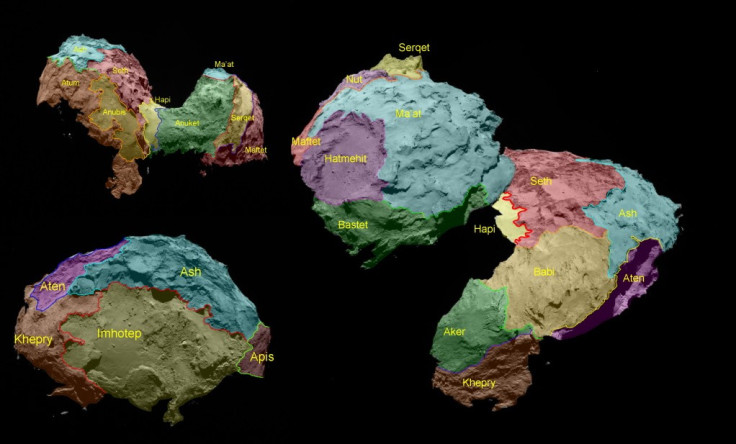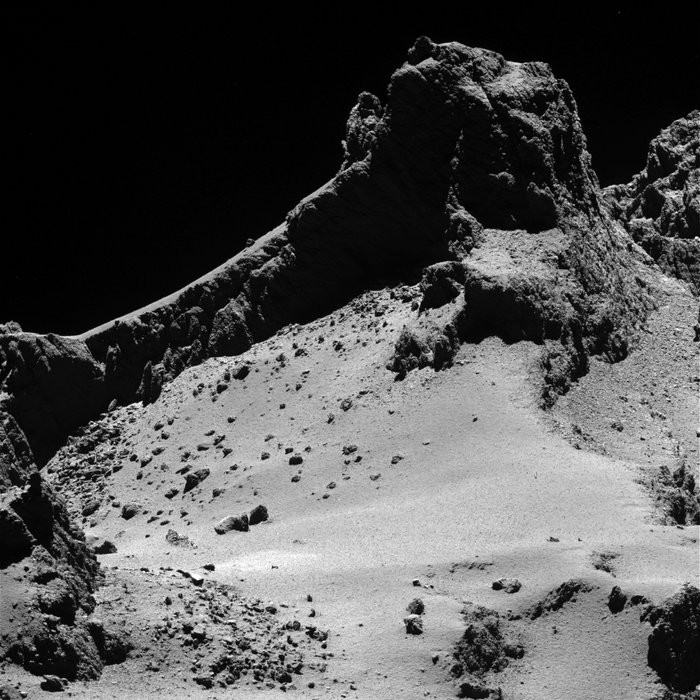Rosetta's camera picks pits, sand dunes and cracks on Comet 67P surface

The camera aboard ESA's Rosetta spacecraft reveals strange "goose bumps" and distinct structures on the surface of Comet 67P/Churyumov-Gerasimenko, in images taken from 8 km above it.
These mysterious features appear on the comet's cliff walls and are estimated to be about 9.84 feet (3 metres) in diameter.
The appearance of these structures resembling structures found on planetary surfaces is surprising as the comet does not have similar atmosphere or gravity.
The OSIRIS (short for Optical, Spectroscopic and Infrared Remote Imaging System) high-resolution camera has imaged about 70% of the comet's surface.
According to Nicolas Thomas, the co-investigator of the OSIRIS data, the strange features could be the result of outgassing from its active northern region.
Comet 67P/C-G's northern hemisphere is mostly dust. Heating up of the comet causes ice to be released into gas, which forms an atmosphere around it. The gas drags up dust. Some particles, the fast moving ones, escape the comet, while slower ones sink back to the surface.
This out-gassing could cause the features as the high-speed gas expanding into the vacuum of space transports dust across the surface and creates the dunes and ripples.
The scientists have named 19 distinct areas after Egyptian deities. These regions are grouped by the terrain that dominates each sector.
The five basic terrains identified on the comet are dust-covered (regions Ma'at, Ash and Babi), pits and circular structures underlain with brittle materials (Seth), those with big depressions (Hatmehit, Nut and Aten), those with smoother features (Hapi, Imhotep and Anubis) and those with rock-like surfaces, which encompass all of the remaining regions.
Scientists are not exactly sure how the goose-bumps or odd surface features formed on the surface of the comet.
Snowy dustballs
Based on observations so far, scientists think the comet is about 70 to 80% porous, more of a "snowy dustball" than a "dirty snowball", according to Alessandra Rotundi, the principal investigator of Rosetta's GIADA dust grain analyser.
However, the composition of the comet is very diverse, according to Holger Sierks, the principal investigator of OSIRIS.
"You might sink in into the smooth dust where we find the thick snow-field like layers, other areas might be robust enough to carry you," Sierks told Space.com. "The dust is dry like power."
Lead author of the study that appeared in Science, Samuel Gulkis of the Jet Propulsion Laboratory, and his team found that the northern hemisphere of the comet is relatively warm, while the southern hemisphere is somewhat colder, indicating seasonal changes on Comet 67P.
While the Virtis instrument data has yielded evidence of carbon based on the surface of a comet's nucleus, researchers are still unsure if the comet is a contact binary formed when two cosmic bodies get stuck together.
Right now the sunlit side of the comet is dehydrated but as the frozen body nears the sun and the southern half is exposed, that region is also expected to heat up and become active.
The European Space Agency's Rosetta which will be in orbit around the comet as it approaches the Sun will continue to deliver important data.
Launched in March 2004, Rosetta visited Mars, came back to Earth (briefly being misidentified by astronomers as an asteroid), visited asteroid 2867 Šteins 5 and then was back to Earth again; next it dropped in on asteroid 21 Lutetia, before finally reaching 67P in August last year.
Rosetta will remain in orbit around 67P much after its lifetime, tied to the comet by its weak gravitational tug.

© Copyright IBTimes 2025. All rights reserved.





















